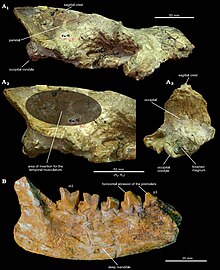| Eurotherium Temporal range: Early to Middle Eocene | |
|---|---|
 | |
| skull and mandible of Eurotherium theriodis | |
| Scientific classification | |
| Domain: | Eukaryota |
| Kingdom: | Animalia |
| Phylum: | Chordata |
| Class: | Mammalia |
| Order: | † Hyaenodonta |
| Superfamily: | † Hyaenodontoidea |
| Family: | † Hyaenodontidae |
| Genus: | † Eurotherium Polly and Lange-Badré, 1993 [1] |
| Type species | |
| †Eurotherium theriodis Van Valen, 1965 | |
| Species | |
| Synonyms | |
synonyms of species:
| |
Eurotherium ("european beast") is an extinct paraphyletic genus of placental mammals from the extinct family Hyaenodontidae that lived from the Early to Middle Eocene in Europe. [1] [6] [7]